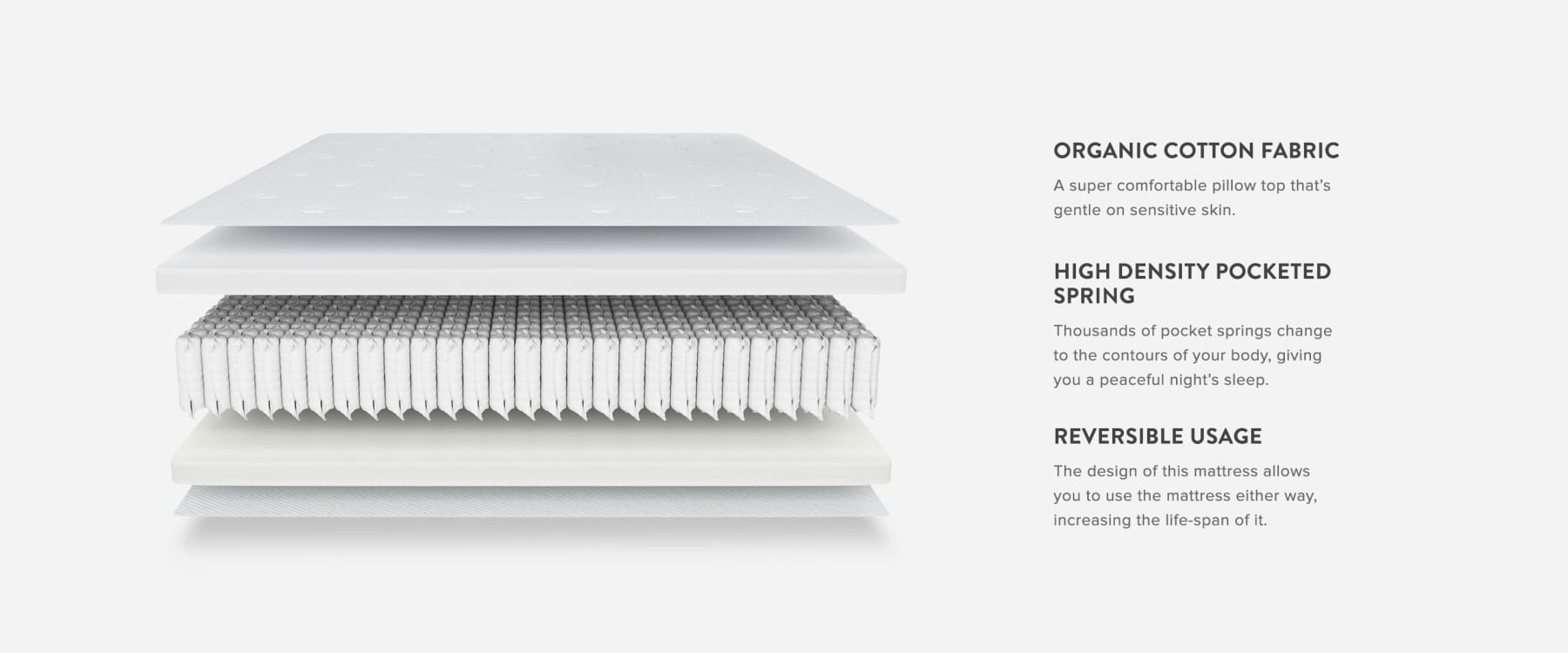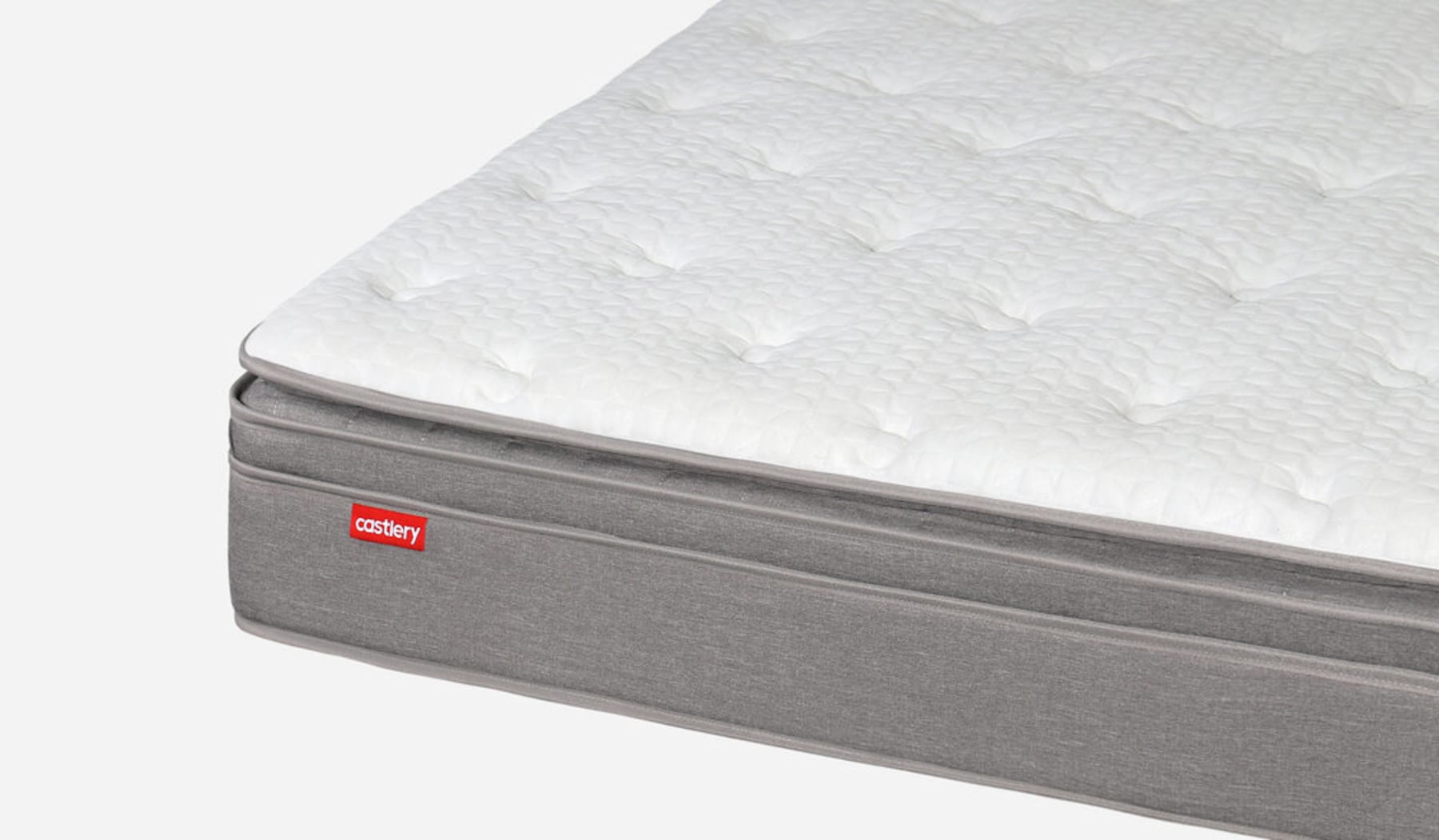
Foam Mattress vs Spring Mattress: Which is Better?
When it comes to choosing the perfect mattress, your options are endless. While this means you have more to choose from, you’re also faced with a challenge - which exactly should you pick?
Foam mattresses and spring mattresses dominate the market and offer distinct features that can greatly impact your sleep quality.
To ensure you have a restful sleep in bed every night, we dive deeper into each mattress type and explore which one is better suited for your needs.
Spring mattresses
Spring mattresses, also known as innerspring mattresses, have been around for decades and are widely recognised for their traditional bounce and support. They consist of a core of metal springs that are typically made from steel and provide the primary support for the mattress.

Spring mattresses like the Alber Mattress often have additional pillow tops to provide extra comfort.
To ensure the spring system remains comfortable, it is usually topped with various layers like fibre and foam to enhance the cushioning.
Types of spring mattresses
Pocket spring
Also known as pocketed coil, pocket spring mattresses are more technologically advanced compared to other spring mattresses.
As each coil is individually wrapped and encased in fabric pockets, they operate independently, allowing for excellent motion isolation, targeted support, and contours to the body's curves.
As a result, pocket spring mattresses have become a preferred choice for their ability to deliver a more customised and isolated sleep experience. On the downside, this also makes them the most expensive option in the spring mattress category.
Bonnell spring
Bonnell spring mattresses are one of the most common and affordable options. They feature an interconnected coil system where the springs are shaped like an hourglass. These mattresses provide a firm and bouncy feel, making them suitable for individuals who prefer a traditional sleep surface with a responsive feel.
Continuous coil
Continuous coil mattresses have a single wire that runs throughout the mattress to create continuous S-shaped coil patterns. This design provides consistent support and durability. While they may not offer the same level of motion isolation as pocket spring mattresses, continuous coil mattresses are generally more affordable and still provide adequate support.
Offset coil
Similar to Bonnell springs, offset coil mattresses feature an hourglass-shaped coil design where each coil is hinged together with helical wires. This design allows for better contouring of the body's curves and helps distribute weight evenly, providing enhanced support and reducing pressure points.
Pros and cons of spring mattresses
| Pros | Cons |
|---|---|
| - Provides sturdy support and firmness
- A responsive surface with a slight bounce - The open structure of the spring coils allows for improved breathability - Generally more budget-friendly than foam mattresses | - Transmits movement across the mattress easily
- Coils may lose their resilience and support after prolonged use, leading to sagging and unevenness - The springs can produce noise or creaking sounds when there is movement - May create pressure points during sleep that can cause discomfort |
Foam mattresses
Even though foam mattresses were invented long after spring mattresses, they have gained immense popularity over time. Made from layers of foam, they help to contour the body, providing excellent support and pressure relief.
Types of foam mattresses
Memory foam
You’ve probably heard of memory foam mattresses, and maybe even owned one before. They are the most popular option in the foam mattress category due to their exceptional pressure-relieving properties and ability to conform to the body’s contours.
Made from viscoelastic foam, the foam moulds to the body’s shape in response to heat and pressure. Memory foam also excels in motion isolation, meaning they absorb and minimise the transfer of movement across the mattress.
Polyurethane foam
Polyurethane foam mattresses, also known as polyfoam mattresses, are made from high-density polyurethane foam and are extremely common in the market. They offer a balance of comfort and support while being more affordable compared to memory foam or latex foam mattresses.
Latex foam
Latex foam mattresses are constructed using either natural or synthetic latex foam. Natural latex foam is made from the sap of rubber trees, which is naturally hypoallergenic and chemical-free. Synthetic latex, on the other hand, is produced using chemical compounds that mimic the properties of natural latex.
Latex foam mattresses offer a responsive and buoyant sleep surface while providing good support and pressure relief. Latex foam is also known for its natural breathability and durability, making it a popular choice among eco-conscious consumers.
Pros and cons of foam mattresses
| Pros | Cons |
|---|---|
| - Distributes body weight evenly and reduces pressure points
- Absorbs and minimises motion transfer - Naturally hypoallergenic and resistant to common allergens - Provides personalised support by conforming to the body's shape | - Higher tendency to retain heat
- Temporary odour, known as off-gassing, may be off-putting to some - Lacks immediate bounce and responsiveness - Generally more expensive than spring mattresses |
Foam vs Spring mattresses: A comparison
Sleeping position

Depending on your sleeping position, some mattresses can provide better support than others. Picture credits: @samandmonica
One of the most important factors to consider when deciding between the two mattresses is your sleeping position. Everyone sleeps in a different way, and each type of mattress can provide you with individualised support.
Foam mattresses: If you’re a side sleeper, you would benefit from using memory foam mattresses. They provide excellent pressure relief for the shoulders and hips, aligning the spine and reducing the risk of developing pressure points.
Spring mattresses: Spring mattresses are great for stomach sleepers as they provide firmer support to prevent excessive sinkage and maintain proper spinal alignment.
If you’re a back sleeper, you have it easier as you can choose from both foam and spring mattresses! It then all comes down to your personal preferences when deciding between the two.
Body weight
Body weight is another factor to keep in mind because it directly affects how the mattress will feel and perform in terms of support and comfort.
Foam mattresses: Foam mattresses can provide sufficient support and contouring for lighter individuals. A softer foam mattress may offer a more plush feel for lighter sleepers.
Spring mattresses: Heavier individuals often benefit from the firm support provided by spring mattresses. Pocketed spring mattresses with thicker coils can prevent excessive sinkage.
Temperature regulation

The Cornell Mattress features premium supportive foam, a luxurious organic cooling top, and double pocket springs for extra comfort.
Aside from choosing a cooling bed sheet, picking a temperature-regulating mattress can definitely help to beat the heat - especially in Singapore’s hot and humid weather.
Foam mattresses: Foam mattresses have a reputation for retaining heat. However, advancements in foam technology have led to the development of open-cell foams and gel-infused foams that promote better airflow. Do keep in mind that these types of foams may come at a higher price point.
Spring mattresses: Spring mattresses generally have better airflow due to the open structure of the coil system. This enhanced breathability allows for efficient heat dissipation, making them suitable for individuals who tend to sleep hot.
Motion isolation

If you share a bed, choose a mattress that absorbs motion for undisrupted sleep. Picture credits: @abbie.ensign
If you share the bed with your partner, kids, or pets, you probably wouldn’t want to wake up every single time they move in their sleep or get out of bed.
Foam mattresses: Foam mattresses, particularly memory foam, are excellent in motion isolation. They absorb and minimise the transfer of movement, making them ideal for couples or light sleepers who are easily disturbed by their partner's movements during sleep.
Spring mattresses: While spring mattresses can vary in terms of motion isolation, pocket spring mattresses are generally better at reducing motion transfer. The individually wrapped coils operate independently, isolating movement to specific areas of the mattress.
Backaches and pains
If you suffer from backaches, selecting the right mattress is crucial to promote proper spinal alignment, alleviate pressure points, and provide adequate support.
Foam mattresses: Foam mattresses are generally not recommended if you suffer from back pain. But, if you must, opt for firmer foams to provide sturdy support, relief pressure points, and cushioning all at the same time.
Spring mattresses: Spring mattresses, especially pocket spring mattresses, are great for alleviating back pains. They offer great spinal alignment, comfort, and support.
So which mattress type is better?
Choosing between a foam mattress and a spring mattress is a personal decision that depends on several factors like your specific sleep positions, body type, and motion isolation.
Choose a foam mattress if you’re a light and side sleeper who shares the bed with your partner, pet, or child. Foam mattresses help to absorb movement, providing you with undisturbed rest and adequate support for your shoulders and hips.
Spring mattresses are great for hot sleepers or those with back pain as they help regulate heat and provide excellent support for the spine.
Ultimately, consider your individual needs and priorities to find the mattress that will provide you with the best sleep experience and ensure restful nights for years to come.